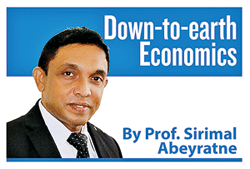A country with no import controls
View(s):What would be the economic consequences of such a bold move? How would this decision shape the future of the Sri Lankan nation? Today, I aim to address these questions by challenging “opinion-based economics” and advocating for a shift towards “principle-based economics.”

Gemstones is one export the country can be proud of.
Free trade regimes
“The US is abandoning the system that made it prosperous.” This has been the central theme of recent speeches by several world leaders in response to US reciprocal tariffs. But what exactly is this system that contributed to America’s prosperity?
A technical answer in one word is “free trade.” However, in a broader sense, it refers to a “free market” system—where free trade plays a crucial role in establishing a rule-based economic framework for private enterprise.
The application of the free trade principle differs from its technical definition. Technically, free trade implies zero tariffs and absence of non-tariff barriers on imports. Yet, in reality, no country operates under absolute free trade or without non-tariff barriers, because while trade may be free, it is also rule-based.
Consider one of Asia’s most open economies—Singapore. While imports are largely tariff-free, specific products such as alcohol, tobacco, motor vehicles, and certain petroleum products are subject to import taxes. Additionally, non-tariff barriers exist, including licencing requirements and regulatory measures related to safety, security, environmental concerns, and quality standards.
The US, too, has historically functioned as a free trade economy, yet it maintains tariffs ranging from
2.5 per cent to 25 per cent in certain cases. Furthermore, licensing requirements and regulatory barriers are imposed on sensitive imports, ensuring that free trade operates within a structured framework.
200-year-old answer
If a country decides to adopt a free trade regime, what would be the outcome? The answer to this question has been understood for over two centuries, rooted in the principle of comparative advantage—a concept introduced by the renowned economist David Ricardo in his 1821 publication “On the Principles of Political Economy and Taxation”.
Ricardo illustrated this principle through a well-known case study of his time: the production and exchange of wine and cloth between Portugal and England. In his own words, he said:
“If Portugal had no commercial connection with other countries, instead of employing a great part of her capital and industry in the production of wines, with which she purchases for her own use the cloth and hardware of other countries, she would be obliged to devote a part of that capital to the manufacture of those commodities, which she would thus obtain probably inferior in quality as well as quantity.”
 In simpler terms, Portugal could impose import controls and aim for self-sufficiency by producing both wine and cloth domestically. However, Portugal has a comparative advantage in wine production, meaning it can produce wine more efficiently than cloth.
In simpler terms, Portugal could impose import controls and aim for self-sufficiency by producing both wine and cloth domestically. However, Portugal has a comparative advantage in wine production, meaning it can produce wine more efficiently than cloth.
If Portugal insists on producing both wine and cloth while restricting imports, it would be forced to allocate resources inefficiently manufacturing goods it does not produce optimally. As a result, both the quality and quantity of production would suffer.
Thus, the principle of comparative advantage demonstrates why countries benefit from free trade. By specialising in what they do best and exchanging them for other goods, they can foster economic growth and prosperity rather than squandering resources in pursuit of unrealistic self-sufficiency.
Superior outcome
If Portugal chooses to embrace free trade, it would focus on producing more and better wine, while its inefficient cloth production would naturally decline. Instead of manufacturing cloth domestically, Portugal would import it from England, where production is more efficient, ensuring higher quality and lower costs. Ultimately, free trade benefits both Portugal and England, as each nation specialises in what it does best.
Ricardo’s case study illustrates the fundamental economic distinction between free trade and self-sufficiency. Even after 200 years, the principle of comparative advantage remains undisputed, continually reinforced by economic evidence.
Yet, if we ask people to choose between free trade and self-sufficiency, many—especially in countries like Sri Lanka—would favour self-sufficiency. This preference is not surprising, since even some economists advocate the same idea.
The emotional and ideological attachment to self-sufficiency often overshadows the economic rationale for free trade. Nationalist sentiments and political romanticisms frequently triumph over sound economic principles, influencing decisions that shape society. After all, opinion-based economics—rather than principle-based economics—continue to guide many policy discussions.
Free trade scenario
Sri Lanka’s import trade operates under a complex and protective regime, consisting of tariffs, para-tariffs, non-tariff barriers, special duties, domestic taxes, and other protective measures. However, this system is now being disrupted by the US reciprocal tariff announcement.
To effectively respond to these reciprocal tariffs, Sri Lanka has no viable option other than eliminating its restrictive import controls. But what would be the economic implications of transitioning to a free trade regime?
To assess this, we must distinguish between short-term and long-term outcomes.
- Short-term impact: The immediate effect of removing import controls, which is often referred to as adjustment costs, could be disruptive. As Ricardo’s case study highlights too, some domestic industries may collapse, unable to compete with imports—especially those that have survived only due to protectionist policies.
- Long-term benefits: Over time, free trade promotes the expansion of competitive industries, shifting the focus toward international markets. Access to a larger, unrestricted global market offers opportunities for industry growth and cost reduction through economies of scale. This, in turn, enhances
Sri Lanka’s economic competitiveness, making its industries more resilient and efficient.
Ultimately, while the transition to free trade involves short-term challenges, its long-term advantages foster economic strength, innovation, and global integration.
Handloom and apparel industries
Let’s take a practical example from Sri Lanka’s own experience. When the economy was liberalised in 1977, the domestic handloom industry collapsed, leading to job losses for several thousand workers in the sector.
However, over time, an internationally competitive apparel industry emerged, expanding significantly. Not only did it create approximately half a million new jobs, but it also advanced to higher stages of the value chain, strengthening Sri Lanka’s position in the global market.
If we reflect on the impact of trade liberalisation in 1977, which should we value more—the lost handloom industry or the booming export-oriented apparel sector?
A free trade regime, combined with a supportive business environment, is fundamental to attracting investment aimed at international markets. As a result, higher economic growth, income generation, and job creation are more strongly linked to free trade than to protectionist policies.
Poverty reduction
One of the immediate effects of removing import controls is a reduction in prices for both consumers and producers in the local market. Import restrictions drive up the cost of essential goods, disproportionately affecting the poor and contributing to persistent poverty.
Countries like Sri Lanka maintain protective trade barriers, leading to higher domestic prices while simultaneously struggling to allocate public funds for social protection programmes. In contrast, nations that embrace trade liberalisation have successfully lowered consumer prices, while also generating jobs and income for low-income populations.
Beyond consumer benefits, removing import controls also reduces production costs. Access to higher-quality inputs at lower costs enhances competitiveness in free trade economies compared to those operating under protectionist policies.
Trade hypocrisy
Furthermore, there is an inherent moral dilemma in enforcing import controls while expecting other countries to maintain open trade policies. This hypocrisy in trade policy—which Sri Lanka has also practiced in the past—is precisely why the nation now faces uncertainty following the US reciprocal tariff announcement.
The US policy shift has forced protectionist economies to reconsider their approach. For Sri Lanka, one of the most critical responses available is to begin dismantling excessive import restrictions, paving the way for a more open and competitive trade environment.
(The writer is Emeritus Professor at the University of Colombo and Executive Director of the Centre for Poverty Analysis (CEPA) and can be reached at sirimal@econ.cmb.ac.lk and follow on Twitter @SirimalAshoka).
Hitad.lk has you covered with quality used or brand new cars for sale that are budget friendly yet reliable! Now is the time to sell your old ride for something more attractive to today's modern automotive market demands. Browse through our selection of affordable options now on Hitad.lk before deciding on what will work best for you!


